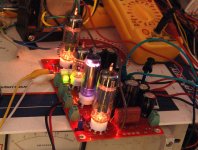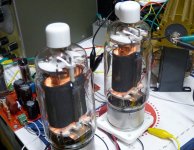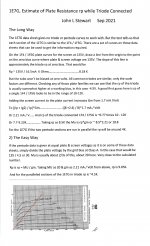Aaaahhhh, if you drop the octal requirement, there is 829/832 family to choose from. Johnson sockets for same are not so bad to come by either.
cheers,
Douglas
cheers,
Douglas
We certainly got far away from the Original Poster's question.
But here goes:
With the same 7 pin Septar socket as the good looking 829 and 832,
So check out the dual beam power tube, the 5894 . . . It looks real cool.
By the way, these all have Beam Formers.
And all 3 types are High Power Tubes; they are not Low power tubes.
Also, they are not true Pentodes, they do not have a G3 Suppressor Grid with real grid wires.
I think the OP's request for 2 low power pentodes, with octal base is very limited.
A search of the Compactron tubes (different socket) might yield a pair of low power Pentodes or low power Beam power, perhaps with a triode thrown in for good measure.
Some parts are in the category rare, or even Un-Obtanium.
Certain other parts are Obsolete-ium.
Or get some hearing aid miniature battery pentodes and connect them to an 8 pin Octal base.
But here goes:
With the same 7 pin Septar socket as the good looking 829 and 832,
So check out the dual beam power tube, the 5894 . . . It looks real cool.
By the way, these all have Beam Formers.
And all 3 types are High Power Tubes; they are not Low power tubes.
Also, they are not true Pentodes, they do not have a G3 Suppressor Grid with real grid wires.
I think the OP's request for 2 low power pentodes, with octal base is very limited.
A search of the Compactron tubes (different socket) might yield a pair of low power Pentodes or low power Beam power, perhaps with a triode thrown in for good measure.
Some parts are in the category rare, or even Un-Obtanium.
Certain other parts are Obsolete-ium.
Or get some hearing aid miniature battery pentodes and connect them to an 8 pin Octal base.
Last edited:
Don't worry 6A3, the 6DZ7 is a pair of beamers too... 🙂
The adapters Idea will let you get away with Murder. Two 813's anybody? Mind sensible voltage limits if you take the anodes to a pin on the octal socket...
Use those for another pair of filament connections; 5A is pushin' it for an octal contact( or the 6336 would have been bigger ).
cheers,
Douglas
The adapters Idea will let you get away with Murder. Two 813's anybody? Mind sensible voltage limits if you take the anodes to a pin on the octal socket...
Use those for another pair of filament connections; 5A is pushin' it for an octal contact( or the 6336 would have been bigger ).
cheers,
Douglas
Bandersnatch,
The Screen of an 813, by any other name is a Power Anode (22 Watt dissipation).
. . . An 807 plate dissipation is only rated a little bit higher, 25 Watts.
Just ground the 813 plate cap, it makes the 813 into a triode, it will then be electrically safe to touch the top cap, but the hot filament and hot screen will cause your fingers to burn.
The filament, 10V @ 5A dissipates 50Watts
The screen at operated at max 22 Watts
72 Watts of heating power for your fingers.
The Screen of an 813, by any other name is a Power Anode (22 Watt dissipation).
. . . An 807 plate dissipation is only rated a little bit higher, 25 Watts.
Just ground the 813 plate cap, it makes the 813 into a triode, it will then be electrically safe to touch the top cap, but the hot filament and hot screen will cause your fingers to burn.
The filament, 10V @ 5A dissipates 50Watts
The screen at operated at max 22 Watts
72 Watts of heating power for your fingers.
If you are going to use a g2 as anode, get a real one. Type GU81m comes in at 120W, and it is a three-grid pentode. It does need 150W to heat its cathode...LOL and I'd not want to balance two sockets on a single octal...let alone trying to squeeze 25A of 12V through an octal socket...heh-heh-heh
cheers,
Douglas
cheers,
Douglas
My original question came about as I noticed that you can run a pentode LTP with common g2.
Just curious, are/were there any low power dual pentodes in octal?
Pentode LTP's work quite well. The performance improves as the Gm of the tubes increase. I tried dozens of different tubes in Pete Millett's original Engineers Amp finding that a pair of 6EW6's work good. By the time high Gm pentodes were common in TV sets the "go to" tube package was a miniature 7 or 9 pin tube. Any new "dual" version would likely have come in a Compactron envelope. The dual 6EW6 is the 6J11. It's not an octal, but the socket is the same diameter so that it might work for your application.
I ultimately found the best tube for the LTP in Pete's amp (7 pin socket) was the 6GU5, a beam hexode with a 15000 Gm. For my own LTP designs I prefer the 9 pin miniatures since there are several types with the same pinout as the 6EJ7 which works well itself.
Thanks George, That historical perspective explains it. There appears to be a perception among some members that 8 pins are not enough for a dual pentode. I'm sure if there was a need, the manufacturers would have brought out one plate or grid to a top cap and you'd have the same number of pins as a noval.
I have no need or desire to put a dual pentode into an octal socket. I was just curious to understand why I hadn't found any.
I have no need or desire to put a dual pentode into an octal socket. I was just curious to understand why I hadn't found any.
We certainly got far away from the Original Poster's question.
But here goes:
With the same 7 pin Septar socket as the good looking 829 and 832,
So check out the dual beam power tube, the 5894 . . . It looks real cool.
By the way, these all have Beam Formers.
And all 3 types are High Power Tubes; they are not Low power tubes.
Also, they are not true Pentodes, they do not have a G3 Suppressor Grid with real grid wires.
I think the OP's request for 2 low power pentodes, with octal base is very limited.
A search of the Compactron tubes (different socket) might yield a pair of low power Pentodes or low power Beam power, perhaps with a triode thrown in for good measure.
Some parts are in the category rare, or even Un-Obtanium.
Certain other parts are Obsolete-ium.
Or get some hearing aid miniature battery pentodes and connect them to an 8 pin Octal base.
In terms of 'easy', and 'possible', an adapter to run a pair of 6V6GTA from a single octal is looking quite appetizing. For a build that would use such a thing, might as well jus' put in a second socket.
Or a 9-pin pair. EF184 as Tubelab suggests comes to mind, though I'd take EL84 myself. Or 6CL6, or one of the 9-pin 6W6-ish tubes( 1.2A of heater current in a 12AX7-sized bottle ), though I have not gone beyond grabbing a sleeve or two to play wid at some point.
cheers,
Douglas
The pentode part has each g3 brought out separate and not connected to k, but both g1 and g2 are common. Apparently that was useful for Sync/agc duty in tv service.
That 6BA11 is one of those dual control split pentodes like 6BU8, 6KF8, 6MK8, 6GS8, 6HS8, 6LE8. G1 sets the overall current and the two g3's set the partitioning of the current between the plates. 6LE8 is a bigger version.
6BV11 is a dual dual-control pentode. 7AK7 and 6888 are Octal single versions. 9KC6 is a frame grid version.
I had boxes full of these tubes. They are virtually useless as an LTP due to the very low Gm of G3. The original application used G3 for an on-off gate.
Some dual control pentodes can indeed be used as very good pentodes, or even triodes with a small positive voltage on G3.
Some are marginally useful in variable gain amps, but the older dual control pentodes like the 6AS6 work better for that application. I went through dozens of tubes for use in a variable gain amp for a Fairchild 670 style compressor stage in a vacuum tube music synthesizer. I wound up using ordinary TV IF amp pentodes like the 6EW6 or 6EJ7/EF184. The 6EH7/EF183 is designed for such use, but it requires a much larger control voltage swing.
Many of the IF amps tubes have an often undocumented variable pitch grid making them somewhat nonlinear. This can create distortion when used for audio, especially at large signal levels. The distortion is mostly even order which cancels in an LTP or other P-P circuit like the Fairchild VGA cell.
My original question came about as I noticed that you can run a pentode LTP with common g2. I was looking at the schematic for the Citation II.
HK did not choose the 12BY7 for no reason. It was originally the video amp tube in many TV sets. With excellent linearity and a Gm of 11000 it's a good choice for an LTP, as well as general audio amplification. The 12BY7 is also a good choice for a medium power (3 to 5 watts output) RF amplifier, so it became the driver tube an many ham radio transmitters and the output tube in some CB radio sets. That's why it is relatively scarce today. The 12GN7A, 12HG7 and 12HL7 can often be used in the same circuit with minor resistor changes.
Most of the tubes mentioned in this thread are overkill for LTP duty even though they may work. It is possible to put a pair of 6HB6's into Pete's driver board, then wire the driver board directly to an OPT without an output stage and make a decent 7 watt amp. That was limited by the current available rom the CCS in the tail, a 10M45 with the current set resistor shorted.
With that, you can choose any appropriate output tube......
Attachments
Oh yeah. There is the 1E7G dual directly heated Octal pentode. Makes a nice triode too, mu around 10 I think:
Was a power pentode in battery days. A small pentode by later standards.
Hi smoking-amp,
Thanks for posting about the 1E7G.. Would you happen to know its plate resistance when Triode Wired (one pentode section) in the typical operating plate voltage of ~135V? Thanks!
Would you happen to know its plate resistance when Triode Wired (one pentode section) in the typical operating plate voltage of ~135V? Thanks!
1st of all, it is not possible to run one section separately in triode mode since the screen grid is common to both (unless grid1 were neg. enough to turn the other section off completely).
I have a note scribbled in my GE Handbook that Rp is 3300 Ohms for both sections in parallel at 9 mA total. Mu around 10. That would be an approximate, eyeball figure from some curve trace.
It would take a whole bank of these to run as an output stage to get the Rp down enough, just 3 Watt diss for a parallel combo besides.
@TubeLab:
quote:
Some dual control pentodes can indeed be used as very good pentodes, or even triodes with a small positive voltage on G3.
:unquote
What about G1 / G3 connected ?
I remember a 6BF11, dissimilar dual pentode, section #1 power pentode 6.5Watt, section #2 dual control similar to 6BV11. Huge distortion with zero or positive G3. Distortion went down by an order of magnetude at least when G1 & G3 were connected in parallel as control grid ...
quote:
Some dual control pentodes can indeed be used as very good pentodes, or even triodes with a small positive voltage on G3.
:unquote
What about G1 / G3 connected ?
I remember a 6BF11, dissimilar dual pentode, section #1 power pentode 6.5Watt, section #2 dual control similar to 6BV11. Huge distortion with zero or positive G3. Distortion went down by an order of magnetude at least when G1 & G3 were connected in parallel as control grid ...
Last edited:
1st of all, it is not possible to run one section separately in triode mode since the screen grid is common to both (unless grid1 were neg. enough to turn the other section off completely).
I have a note scribbled in my GE Handbook that Rp is 3300 Ohms for both sections in parallel at 9 mA total. Mu around 10. That would be an approximate, eyeball figure from some curve trace.
It would take a whole bank of these to run as an output stage to get the Rp down enough, just 3 Watt diss for a parallel combo besides.
Hi smoking-amp,
Thanks for the reply.. I was thinking of running both sections at the same time in triode mode, for the left and right channels respectively, in a preamp application.. I appreciate all the info, especially that note on your GE Handbook.. Thanks again!
@TubeLab:
quote:
Some dual control pentodes can indeed be used as very good pentodes, or even triodes with a small positive voltage on G3.
:unquote
What about G1 / G3 connected ?
I have never actually tried this so I'm not sure what will happen.
I have a note scribbled in my GE Handbook that Rp is 3300 Ohms for both sections in parallel at 9 mA total. Mu around 10. That would be an approximate, eyeball figure from some curve trace.
Here are some numbers calculated by the brute force method. When Smoking Amp does the tests of rp these numbers will not be far off. But they may not look as good, these tubes are now 70-80 years old.
About 20 yrs ago I did build a PP 33 Amp That worked very well. I did some gm tests, the tubes did not test to spec. They would have been 50-60 yrs old then.🙂
Here are some numbers calculated by the brute force method. When Smoking Amp does the tests of rp these numbers will not be far off. But they may not look as good, these tubes are now 70-80 years old.
About 20 yrs ago I did build a PP 33 Amp That worked very well. I did some gm tests, the tubes did not test to spec. They would have been 50-60 yrs old then.🙂
Attachments
I have a note scribbled in my GE Handbook that Rp is 3300 Ohms for both sections in parallel at 9 mA total. Mu around 10. That would be an approximate, eyeball figure from some curve trace.
Here are some numbers calculated by the brute force method. When Smoking Amp does the tests of rp these numbers will not be far off. But they may not look as good, these tubes are now 70-80 years old.
About 20 yrs ago I did build a PP 33 Amp That worked very well. I did some gm tests, the tubes did not test to spec. They would have been 50-60 yrs old then.🙂
Hello jhstewart9,
Thank you for all this data and info!.. It’s more than I could ask for. BTW, that PP 33 must be sweet sounding. Have a great weekend..
- Home
- Amplifiers
- Tubes / Valves
- Octal dual pentodes?



